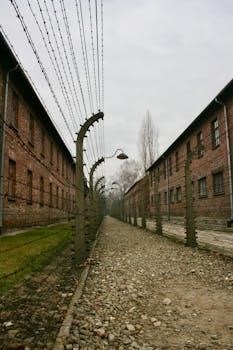This guided reading activity explores World War II and the Holocaust, providing a framework for understanding these complex events. Students will examine the historical context, the rise of Nazism, and the devastating impact of the Holocaust. The activity promotes comprehension and critical thinking skills.
Overview of the Historical Context
The period leading up to World War II was marked by significant global instability and political tensions. The Treaty of Versailles, imposed after World War I, created resentment in Germany, which contributed to the rise of extremist ideologies. The failure of the League of Nations to effectively address international conflicts and aggression further exacerbated the situation. Economic hardship and social unrest in many countries during the Great Depression also created fertile ground for radical movements to gain popularity. This turbulent environment allowed for the rise of totalitarian regimes, most notably in Germany, Italy, and Japan, each pursuing expansionist policies that would ultimately lead to global conflict;
The Rise of Nazism and its Ideologies
This section explores the emergence of Nazism in Germany, focusing on its core beliefs and the factors that allowed it to gain power. The roots of anti-Semitism and Hitler’s vision are examined.
Roots of Anti-Semitism and Nazi Ideology
This section delves into the long history of anti-Semitism in Europe, which provided fertile ground for the rise of Nazi ideology. We’ll explore how centuries of prejudice against Jewish people were exploited by the Nazis to promote their racist agenda. Nazi ideology, rooted in extreme nationalism and the concept of racial purity, built upon these existing prejudices. This ideology, which centered on the idea of a superior Aryan race, served as the foundation for their policies of discrimination and persecution. Furthermore, this ideology was used to justify the planned extermination of the Jewish population.
Hitler’s Vision of a Superior Aryan Race
Adolf Hitler’s worldview was based on the belief in a superior Aryan race, which he defined as primarily of German descent. This concept was central to Nazi ideology and fueled their pursuit of a racially pure society. Hitler envisioned a world where the Aryan race would dominate, and other groups were deemed inferior. This racial hierarchy formed the basis for their policies of persecution and genocide. The perceived inferiority of groups like Jewish people, Roma, and others, was a direct consequence of this twisted vision. This belief led to the horrific events of the Holocaust.

The Path to World War II
The path to World War II was paved with political instability, failed diplomacy, and aggressive expansionist policies. Key events, such as the Treaty of Versailles, contributed to the growing tensions leading to war.
Treaty of Versailles and its Impact
The Treaty of Versailles, imposed on Germany after World War I, played a significant role in setting the stage for World War II. The treaty’s harsh terms, including territorial losses, disarmament, and heavy reparations, fostered resentment and economic instability in Germany. These conditions created fertile ground for extremist ideologies like Nazism to take root and gain popularity. The treaty’s impact extended beyond Germany, contributing to a global climate of unease and dissatisfaction. The treaty’s failures set the stage for future conflicts and ultimately helped lead to the devastating global conflict of World War II.
Appeasement and the Failure of Diplomacy
The policy of appeasement, adopted by Great Britain and France towards Nazi Germany in the 1930s, aimed to avoid war through diplomatic concessions. However, this approach ultimately failed to deter Hitler’s expansionist ambitions. The Munich Agreement, a key example of appeasement, allowed Germany to annex the Sudetenland, emboldening Hitler further. This failure of diplomacy demonstrated a lack of resolve in the face of aggression. The appeasement policy did not address the root cause of the conflict. It allowed Hitler to grow his military might unchecked, leading to the outbreak of World War II.
Key Events Leading to War
Several key events escalated tensions and led to the outbreak of World War II; Germany’s remilitarization of the Rhineland in 1936 violated the Treaty of Versailles and demonstrated Hitler’s defiance. The annexation of Austria in 1938, known as the Anschluss, further expanded Nazi Germany’s territory. Then the Munich Agreement in 1938, also led to the occupation of Czechoslovakia, revealing the ineffectiveness of appeasement. The invasion of Poland by Germany in September 1939 triggered declarations of war by Great Britain and France, officially marking the start of World War II. These aggressive actions by Germany clearly indicated the failure of diplomacy.

The Holocaust⁚ Nazi Persecution
The Holocaust was a systematic, state-sponsored persecution and murder of six million Jews by the Nazi regime and its collaborators. This genocide also targeted other groups deemed “inferior”.
Nazi Persecution of “Inferior” Peoples
Nazi ideology categorized various groups as “inferior,” leading to their systematic persecution. Besides Jews, Roma, Slavs, homosexuals, disabled individuals, and political opponents faced discrimination, forced labor, and murder. The Nazis aimed to eliminate these groups from society, viewing them as threats to their vision of a pure Aryan race. This persecution was a core element of their racist and genocidal policies. The Einsatzgruppen and other forces carried out mass executions, marking a dark chapter in human history. Their actions showcase the extreme consequences of prejudice and hatred, underscoring the need to remember and learn from this period.
The Einsatzgruppen and Mass Executions
The Einsatzgruppen were mobile killing squads, primarily composed of SS and German police, responsible for mass executions in Eastern Europe. Following the German army, they systematically murdered Jews, Roma, and other “undesirables.” These massacres often took place in ravines or forests, with victims forced to dig their own graves before being shot. The Einsatzgruppen’s actions marked a significant escalation in Nazi brutality, transitioning from discrimination to outright genocide. Their operations were a precursor to the industrial-scale extermination in death camps, demonstrating the organized and ruthless nature of the Nazi killing machine. This is a dark example of mass murder during the Holocaust.
The Final Solution and the Creation of Ghettos
The “Final Solution” was the Nazi plan to exterminate the Jewish people, marking the most horrific phase of the Holocaust. This policy aimed at the systematic annihilation of European Jewry. As part of this plan, Jews were first forcibly relocated to ghettos. These were often overcrowded, unsanitary, and isolated sections of cities, designed to control and dehumanize the Jewish population. These ghettos served as holding pens, before the deportation to extermination camps. The creation of ghettos was a crucial step in the process of the Final Solution, isolating the victims from the rest of society and facilitating the implementation of the Nazi genocide.
The Establishment of Death Camps
The establishment of death camps marked the culmination of the Nazi’s “Final Solution.” These camps, primarily located in occupied Poland, were designed for the systematic extermination of Jews and other targeted groups. Unlike concentration camps which focused on forced labor, death camps were equipped with gas chambers and crematoria to kill large numbers of people quickly. Auschwitz-Birkenau, Treblinka, and Sobibor were among the most infamous. The process involved the transportation of victims from ghettos, their arrival at the camps, and the immediate mass murder of most. The establishment of these camps was a deliberate and calculated effort to achieve genocide on a vast scale.
World War II and its Impact on Civilians
World War II profoundly impacted civilians worldwide. The war led to mass displacement, immense suffering, and significant social changes. The conflict caused widespread turmoil, and changed the lives of millions.
The War’s Impact on the Soviet Union
The Soviet Union bore a tremendous burden during World War II, experiencing immense devastation and loss of life. Millions of Soviet citizens perished in the conflict, both on the front lines and in occupied territories. The war led to widespread destruction of infrastructure, including cities, factories, and farmland. The brutal fighting on the Eastern Front resulted in immense suffering and long-lasting trauma for the Soviet population. The war effort required enormous sacrifices from the Soviet people, impacting their daily lives and reshaping the nation’s social and economic landscape. Additionally, the war highlighted the ideological differences with the West, contributing to post-war tensions.
Social Turmoil in the United States
While the United States did not experience the same level of physical destruction as Europe, World War II caused significant social upheaval. The war effort led to a surge in industrial production, drawing many Americans into the workforce. However, this economic boom also resulted in labor shortages and social tensions. Japanese Americans faced discrimination and were unjustly interned in camps. The war also fueled debates about race and segregation within the United States. The war’s impact on American society was profound, raising complex questions about citizenship, equality, and national identity that would continue to shape the country in the postwar era.

The End of World War II
The war concluded with Allied victory, followed by the Nuremberg trials to address Nazi atrocities. The United Nations was established, but post-war tensions arose, setting the stage for the Cold War.
Allied Victory and the Aftermath
The Allied forces achieved victory in World War II, leading to the unconditional surrender of both Japan and Germany. This triumph was followed by a period of immense change, including the establishment of the United Nations, aimed at preventing future global conflicts. However, the post-war world was characterized by considerable tension, particularly between the Soviet Union and the Western powers. The issue of self-determination in Eastern European nations became a significant point of contention, creating a climate of mutual suspicion. The conflict led to a new geopolitical landscape that set the stage for the Cold War, impacting global relations for decades to come.
The Nuremberg Trials
Following World War II, the Nuremberg Trials were conducted to bring Nazi leaders to justice for war crimes, crimes against peace, and crimes against humanity. These landmark trials held individuals accountable for the atrocities committed during the Holocaust and the war. The proceedings were designed to establish legal precedents for prosecuting such crimes in the future, creating a foundation for international law. The trials served as a crucial step in acknowledging the scale of Nazi crimes, offering a form of justice to the victims. They also brought to light the details of the Holocaust and the suffering inflicted upon millions of people, solidifying their place in history.

Legacy of World War II and the Holocaust
The aftermath of World War II and the Holocaust led to the creation of the United Nations. This was aimed at preventing future conflicts. The Cold War emerged, and remembering the Holocaust is crucial.
Establishment of the United Nations
Following the devastation of World War II, the global community recognized the urgent need for an international organization to foster peace and prevent future conflicts. The establishment of the United Nations in 1945 was a direct response to the war’s atrocities and aimed to provide a platform for diplomacy and cooperation among nations. The UN’s charter emphasized human rights, international law, and collective security, reflecting the lessons learned from the war and the Holocaust. This new body sought to address global issues, promote development, and maintain peace. It was a critical step towards building a more stable and just world.
The Cold War and Post-War Tensions
The end of World War II did not usher in an era of universal peace; instead, it gave rise to new tensions and conflicts. The ideological clash between the Soviet Union and the Western powers, particularly the United States, led to the Cold War. This period was characterized by a nuclear arms race, proxy wars, and deep political divisions. The issue of self-determination in Eastern Europe further exacerbated these tensions. The post-war landscape was marked by mutual suspicion and the formation of opposing military alliances, significantly shaping global politics for decades to come. This era showed the fragility of peace.
Remembering and Learning from the Holocaust
Remembering the Holocaust is crucial to ensure such atrocities never happen again. It serves as a reminder of the dangers of unchecked hatred, prejudice, and discrimination. Learning about the Holocaust involves understanding its historical context, the systematic nature of the persecution, and the devastating impact on its victims. By studying this dark chapter in human history, we aim to cultivate empathy, promote tolerance, and encourage active participation in combating all forms of injustice. The lessons learned are not limited to the past but remain relevant in confronting contemporary issues of intolerance and discrimination. We must always remember the victims.
